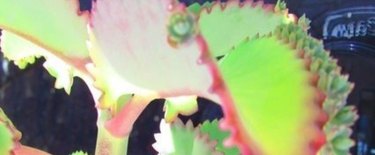

The second Sunday of May is right around the corner, so have you decided how to show Mom appreciation this year? Given my passion for plants, it's no surprise that I consider a houseplant the perfect gift, and I'm ready with a suggestion: a mother of thousands succulent. It's unique (like mom!), not wildly expensive, and very easy-care, and it goes well with a note of love and admiration.
Mother of thousands is a thick-leafed plant in the Kalanchoe genus with an unusual growth pattern: Little plantlets emerge and grow all around the edges of their scalloped leaves. Mother of thousands plants don't need a lot to be happy and thrive; think direct sunlight, well-draining soil, and low humidity. (Wouldn't it be nice if all mothers were that easily satisfied?)
Video of the Day
Video of the Day
Kalanchoe daigremontiana Highlights
- Botanical name: Kalanchoe daigremontiana
or Kalanchoe x laetivirens
- Easy-care? Yes!
- Light: Full or partial direct sun
- Watering: Water every few weeks during the growing season
- Growth rate: Slow-growing
- Flowering: Winter flowers appear on a stalk. Not a reliable bloomer indoors.
- Pet-Safe? No! Toxic to dogs and cats.
All About the Mother of Thousands
It doesn't take a botanist to figure out why this plant is called mother of thousands! One look and bingo—you see where its common name comes from. Two species of plant are commonly called mother of thousands, Kalanchoe daigremontiana and Kalanchoe x laetivirens, and they look alike. Both have thick leaves that develop plantlets around the edges.
Each plant can develop thousands of these tiny plantlets, sometimes in shades of blue or red. To me, the plant looks like it is rimmed in jewels, but each plantlet can grow into a full-size plant. These drought-tolerant succulents can grow to a yard tall over time and are always an attention-grabber.
Kalanchoe, like so many other exotic succulents, is native to the African island nation of Madagascar, an area known for its astounding biodiversity. Mother of thousands has been cultivated around the world and has naturalized in other warm regions, like Hawaii, Florida, and South America. Given its many, many babies, the plant can be invasive if it escapes cultivation.

Care and Feeding of Mother of Thousands
One thing I've learned from living in San Francisco is that succulents are the lazy gardener's best friend. You get them, you plant them, you propagate them if you need more, and then you can sit around drinking coffee. While succulents will only thrive outdoors in the warmest hardiness zones, anyone can have an easy-care succulent houseplant.
Mother of thousands is an exceptional houseplant, exciting interest but requiring very little assistance to thrive. Make sure you set it up correctly. If you meet its few cultural requirements, you may have a plant for life. The plant only needs sun, well-draining soil, and water every few weeks to be happy.
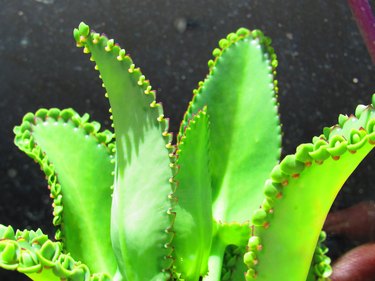
Best Location for Mother of Thousands
Learn from my mistake: A sunny window is not negotiable for this succulent. Many of my indoor plants, like pothos, spider plant, and corn plant, will go with the flow in a low-light area. But I saw my mother of thousands floundering in the dark office. It wants a few hours of direct sun daily, so put it in a west-facing window, and it will thrive.
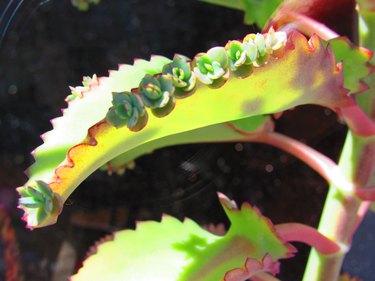
Potting Soil for Mother of Thousands
Wet feet will kill a succulent, so this means well-draining soil is required. You can't go wrong with soil made for cacti or succulents, and make sure the container has drain holes.
Air Temperature and Humidity for Mother of Thousands
Your household temperatures will be just fine for this houseplant. It won't tolerate cold temperatures of 40 degrees Fahrenheit or lower. Temperatures between 50 and 75 degrees are ideal.
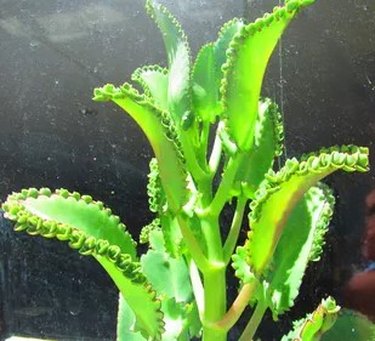
Watering Your Mother of Thousands
Yes, you will need to water your mother of thousands; just think of all those little plantlets trying to grow! But only water during the growing season (May through September) and even then, let a few weeks pass between waterings. For succulents, too much water really is worse than too little.
Best Fertilizer for Mother of Thousands
My rule for fertilizing succulents is simple: Just say no. If you must, use balanced, diluted liquid houseplant fertilizer very infrequently during the growing season.
Propagating and Transplanting
Mother of thousands plants don't need a lot of help dropping babies—and I do mean literally dropping. As the little plantlets mature and fall from mom's leaf to the soil, they are ready, willing, and able to grow. I thought I was being proactive about removing the babies from the topsoil around my plant, but several made it through, and little plants developed right at Mom's skirt hem.
If you'd prefer to act more intentionally, who can blame you? Here are the super-simple steps to follow:
- Carefully pluck off one or more plantlets from the mother's leaf edge. The alternative is to wait until late winter when the babies drop from the leaves.
- Planting is easy: You simply prepare a container with well-draining soil and place the plantlets on top of the soil. Mist the soil and then wait for the plantlets to do their thing.
- Once a little plantet has grown roots, pot it up just like a grown mother of thousands. Ideally, use a terracotta pot and succulent or cacti specialty soil.
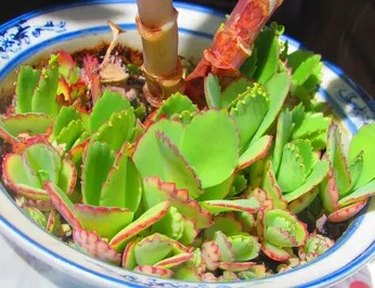
Repotting a Mother of Thousands
Mother of thousands plants grow slowly and rarely need repotting. If you see roots poking out of the bottom drain holes or the plant's size causes the pot to fall over, then yes, it's time to repot. Get a pot one size bigger than its current container and put a few inches of well-draining soil into the pot. Tip the root ball of the mother of thousands out of its old pot and transfer it into the new one. Fill in the sides with succulent soil but leave at least an inch on top to give yourself room to water.
Types of Mother of Thousands Plants
While there are two similar Kalachoe species known as mother of thousands, you'll find a few other plants with similar common names. There are also "mother of millions" plants, for example. Let's look at a few options.
- Kalachoe daigremontiana: This is the most common species sold as mother of thousands. It has green leaves, occasionally with purple stripes down the underside. The babies are interesting colors, running from green to pink.
- Kalanchoe x laetivirens: This species looks a lot like the former plant, but the leaves never get purple stripes.
- Kalachoe delagoensis: This plant has oodles and oodles of plantlets around the leaf margins and earned the common name of mother of millions. The leaves are tipped rather than rounded and are silvery-gray instead of green or blue-green.
- Kalachoe fedtschenkoi: Look for interesting coloring on this species: blue leaves with pink margins that become almost eye-popping shades if grown in bright light.
